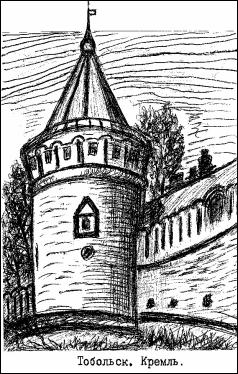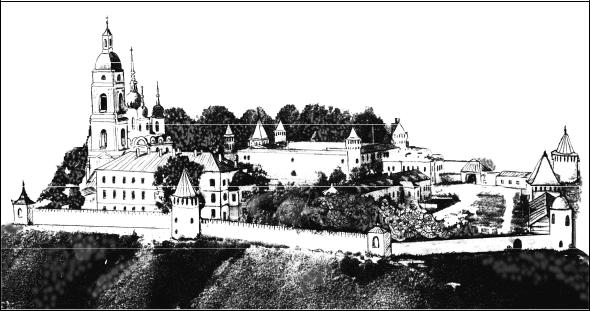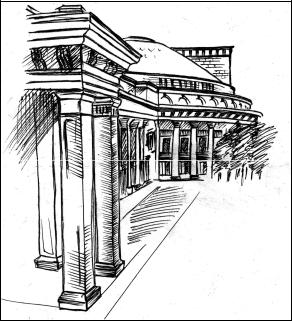
2579
.pdflooks. Spasskaya church in many details resembles the churches of Tobolsk Kremlin but at the same time its appearance has some original motives. Spasskaya church is the only typical example of the Siberian baroque in the Omsk region.
In the museum of local studies one can know about the history of that northern city.
Text 4
BOLSHERECHYE
The history of that ancient Siberian village goes back to the olden times. The campaign of Ermak cleared a wide way for incursion of the Russians to Siberia. Bolsherechye was found in 1627 on the Irtysh river as Bolsheretski outpost.
Today Bolsherechye is a garden settlement with cozy public gardens and park and rest area in the centre of the village, an arboretum at the bend of the Bolshaya river and a cedar grove. Every year the green crown of the settlement becomes more dense and wonderful. There is a wonderful zoo in Bolsherechye stretching out on 19 hectares of a natural landscape.
The only in Russia "Batakovo" national archeological and natural park situated in Bolcherechenski area is also a place of interest. It includes more than 150 wonderful archeological monuments of different epochs from the Stone Age to the late Middle Ages.
Text 5
NIZHNEVARTOVSK
In 1909 at the confluence of the great river of Ob and the river of Vakh a wooden quay appeared. The merchant's steamboats used to moor here to stock up with firewood and then continue their way. Three years later the first houses appeared there.
On March 9, 1972 the settlement received a city status. But a truly legendary revival of Nizhnevartovsk was associated with the discovery of the unique Samotlor oil field. Samotlor is the greatest pearl of the oil necklace of the region. Five petroleum and gas extracting companies work in Nizhnevartovsk area.
Today Nizhnevartovsk is a large industrial, scientific and cultural centre with the population of 237 thousand people and the area of 270 square kilometres. There are 37 high schools, 6 colleges and the teacher's training institute, two theatres, a music academy, art schools and museums in the city.
70
Numerous monuments of history and culture narrate about glorious past and present of the city.
An Orthodox temple – the pride of the city – has been built since 1993 on the citizen's donations. Every morning and in the days of ecclesiastical holidays the bell chime rings all over the city.
The monument to the pioneers of Samotlor was established on the 50th anniversary of Nizhnevartovsk region. A mighty figure of a young worker with a torch in his hand raises above the crossroad of noisy thoroughfares one of which leads to the famous Samotlor.
Text 6
SURGUT
In 1593 a Russian settlement was established in the middle stream of the Ob river. It was called Surgut – the Khanty word for "river mouth rich with fish". It was the stronghold of the Russian state in the region. The aboriginal tribes of the north – Khanty, Mansi and Nenets inhabited Surgut land.
Thirty years ago commercial exploitation of oil fields were commenced in Surgut area. Shortly after the construction of the GRES-1 – the first in the world power plant working on oil-well gas – and later GRES-2 was started. Presently, their total capacity makes more than 8 thousand megawatts. They provide with power not only the northern areas but also the industrial Urals. High-voltage power transmission lines were built and trunk pipelines laid carrying raw hydrocarbons to many regions of Russia and abroad.
The city takes an advantageous geographical location on the crossroad of water routes, motor roads, airways and railways.
Serious structural reorganizations are presently taking place in the city. Today Surgut attracts business people from all over the world.
Surgut dwellers live in friendship and solidarity. A Christian temple and Moslem mosque are being built simultaneously and the preachers of various confessions help to strengthen peace and harmony among the parishioners.
Text 7
KHANTY-MANSIISK
Khanty-Mansiisk city stretches out in a picturesque manner on the wooded hills near the confluence of Irtysh and Ob rivers. Above the others raises Samarovskaya hill covered with dense cedars and silver firs and slim spruces. Under the hill Khanty-Mansiisk quay lies. Some 60 years ago a dense taiga stood like a solid wall on that 100 meter high hill.
71

The ancient settlement and the quay Samarovo were the predecessors of the city. In the 17th century Samarovo sprang up in the place of the settlement of Shanty prince Samar defeated in 1582 by Bogdan Bryazga – the fellow-fighter of Ermak.
Water and taiga surround Khanty-Mansiisk. The passengers will set their feet on land where primeval taiga stood before the foundation of KhantyMansiisk. Old residents of Samarovo tell that formerly bears, squirrels and stoats were hunted where Khanty-Mansiisk has emerged afterwards.
The museum park "Seven hills" with wooden architecture monuments of Khanty and Mansi tribes in one of the sights of the city.
Text 8
TOBOLSK
The city was found in 1568 near the confluence of the Irtysh and Tobol rivers at Chuvashski cape where in 1582 the main battle between the troop of the Russian Cossack named Ermak and the forces of Tartar khan Kuchum took place.
Due to its advantageous geographical location Tobolsk soon became one of the largest centres of Siberia. The intact monuments of the Russian architecture including Tobolsk Kremlin – the first and the only remaining stone Kremlin in Siberia – are the pieces of live history. Wonderful are Sofiisko-Uspenski cathedral – the architectural monument of 17th century – and the monument to Erma (the Don Cossack Vasili Timofeyevich Alenin, whose military campaigns has initiated joining of Siberia to Russia) near the Kremlin.
It that city composer A. A. Alyabyev, scientist D. I. Mendeleyev and artist V. G. Serov were born and the artist V. I. Surikov lived and worked here. From August 1917 to April 1918 the last Russian emperor Nicolai II and his family were kept under arrest here.
The tourist will have an opportunity to see the buildings of Tobolsk Kremlin, admire the majestic panorama opening in front of one's eyes from Chuvashski cape and visit the Prison castle, the functioning theological seminary and the memorial house of Romanov dynasty. Interested persons will visit
72
the functioning monastery and Zavalnoye cemetery where the remains of the Decembrists – V. Kukhelbecker, A. Muravyev, S. Semenov and others – lie.
Text 9
TOMSK
Tomsk is one of the oldest cities in Siberia found in 1604 as the fifteenth Russian fortress. Many architectural monuments remained safe in the city including the church of Resurrection (late 18th century), the buildings of bourgeois board, province administration and the exchange.
Tomsk is famous for its large and absolutely safe historic wooden residential areas turning many districts of the old city into an open-air museum of wooden architecture. The carving decorating the wooden buildings of Tomsk is an essential part of the architecture.
The motives of wood carving are as diverse as its technique and include the outside decoration of the temples, the elements of folk arts (embroidery and braiding) and the motives borrowed from the nature.
The people is a great artist creating according to the laws of beauty and nature. That is where the attraction of Tomsk wooden architecture comes from.
The present-day Tomsk is a large modern city. The division of the Siberian Branch of the Russian Academy of Sciences, 6 higher educational institutions including the oldest university in Siberia found in 1880, more than 200 colleges, several theatres and museums (the museums of local studies and fine arts, architecture and ethnography of Siberia), the Siberian botanical garden and many other places of interest are situated here.
Text 10
TYUMEN
As an administrative unit, Tyumen Region was founded in 1944. It included two ethnic areas - Yamal-Nenets and Khanty-Mansiysk - and 24 districts with a population of approximately one million. Until the early 1960s, the region had been sparsely populated and little explored. In a word, it had been a godforsaken distant province. Its peace was disturbed only in the early 1950s by the invasion of geologists and drillers who discovered oil and gas field there.
Since the region's industrial development began in 1964, over 20 new towns and cities appeared on the map and its population reached 3.3 million.
The cities of Surgut, Nizhnevartovsk and Novy Urengoi have grown substantially and the ethnic district centers of Salekhard and Khanty-Mansiysk have received an impetus for development.
73
Tyumen became a major research, industrial and transport center. The 1960s was the time of industrial development in the north and a construction boom in Tyumen, where research institutes, administrative departments, colleges, cultural clubs, a new railway terminal and new residential districts were built. Today people, belonging to more than 100 nationalities, including over 2 million Russians, 260000 Ukrainians, 228000 Siberian Tartars, 20000 Khanty, 8000 Mansi and others inhabit Tyumen Region.
The peoples of Tyumen are developing their finest traditions and successfully dealing with the problems posed by modem civilization.
2. Give English equivalents for the following phrases and sentences:
КОЛПАШЕВО
1.Колпашево – одно из старейших русских поселений в Западной Сибири.
2.Благодаря природным условиям развивается промышленность: рыбная, лесная, нефте- и газоперерабатывающая.
3.Огромные изменения преобразили жизнь на этой суровой и прекрасной земле.
НАРЫМ
1.Село Нарым, четырехсотлетняя история которого началась в 1596 году с постройки острога…
2.Открытие пароходного сообщения на Оби привело к оживлению торговли.
3.Нарым славился ярмарками, проходившими четыре раза в год.
ТАРА
1.Тара была центром торговли с югом.
2.Тара – современный город с широкими улицами, но связан и с лесной промышленностью, сельским хозяйством, судоходством.
3.В архитектуре улавливается аромат старины. Спасская церковь – единственный в Омской области яркий образец сибирского барокко.
БОЛЬШЕРЕЧЬЕ
1.Сегодня Большеречье – это поселок-сад: уютные скверы, парковая зона, дендрарий, кедровая роща.
74
2.В Большеречье находится замечательный зоопарк на территории 19 га.
3.Археологический парк «Батаково» – это более 150 археологических памятников разных эпох.
НИЖНЕВАРТОВСК
1.На берегу Оби в 1909 году появилась деревянная пристань и первые дома.
2.Самотлор – это самая крупная жемчужина нефтяного ожерелья региона.
3.В городе есть два театра, академия музыки, школа искусств, музеи.
СУРГУТ
1.Русское поселение Сургут в переводе с ханты означает «богатая рыбой пойма реки».
2.Вскоре началось строительство ГРЭС-1 – первой в мире электростанции, работающей на попутном нефтяном газе.
3.Город находится на пересечении водного, автомобильного, авиационного и железнодорожного путей.
ХАНТЫ-МАНСИЙСК
1.Город раскинулся на лесистых холмах близ слияния Иртыша и Оби.
2.Предшественником города было старинное село Самарово: вода и тайга со всех сторон.
3.Одна из достопримечательностей города – парк-музей «Семь холмов».
ТОБОЛЬСК
1.Тобольский кремль – первый и единственный, сохранившийся до настоящего времени в Сибири.
2.В этом городе родились композитор А. А. Алябьев, ученый Д. И. Менделеев, художник В. Г. Перов.
3.Туристы могут увидеть тобольский кремль, посетить тюремный замок, духовную семинарию, монастырь, дом-музей царской семьи Романовых.
75
ТОМСК
1.Томск – один из старейших городов Сибири – был основан в 1604 году.
2.Резьба, украшающая деревянные здания Томска, является неотъемлемой частью архитектуры.
3.Здесь находятся филиал Сибирского отделения Российской академии наук, первый в Сибири университет, театры, музей, Сибирский ботанический сад и другие достопримечательности.
ТЮМЕНЬ
1.До начала 60-х регион был малонаселен и мало исследован.
2.Этнические районные центры получили импульс к развитию.
3.Народы Тюмени развивают лучшие традиции и успешно решают проблемы, поставленные современной цивилизацией.
3.Work in pairs. Ask your partner about his (her) plans for the next holiday. Use information from the texts you have read. Make sentences with the construction "to be going to... "
For example: What place / you / to visit? – What place are you going to visit?
How / you / to travel?
When / you / to travel?
Where / you / to stay?
How long / you / to stay?
What / you / to see / there?
Who / you / to travel / with?
What / you / to do / there?
Where / you / to have meals?
Why / you / to visit / the place?
4. How would you like to spend your time in Siberian cities? Please write about your desires. Use the following phrases:
I'd like...
to see historic houses, castles, cathedrals, palaces, temples. to admire hills, rivers, lakes, forests.
to know about history, culture, traditions and customs of the city. to taste pies with mushrooms, berries, fish.
76

to visit museums, theatres, stadiums, concert halls, cafes, art galleries, night clubs.
to travel round Siberia, along the river.
to buy souvenirs, clothes, shoes, books, CDs, sweets, cigarettes. to meet bears at the streets.
5.There are four texts about Tobolsk. Their titles are "There is a town in Siberia", "Tobolsk", "The convicts' influence upon the cultural life of the town" and "A region, looking to the future". Which of them seems most attractive to you? Why? Can you guess what these texts are about?
6.Read the following texts and think whom these texts can be addressed to:
THERE IS A TOWN IN SIBERIA
We are going to Tobolsk, the former capital of the land which is stretching from the Ural Mountains to coasts of the Pacific Ocean, hence to the town, which now is becoming a centre of Petrochemical, petroleum and gas processing industries of Russia.
Our acquaintance with Tobolsk starts from the town museum reserve which is situated on the territory of the Whitestone Kremlin, the only one of the kind beyond the Urals, standing on a high bank of the Irtysh river.
Tobolsk could hardly be overestimated in development of Siberia. From wooden walls of the Tobolsk Kremlin, during the life of only one generation, the Russian people reached the coast of the Pacific Ocean. The foreigner, Jakob Reitenfels, well versed in the history of Russia wrote: "It is really amazing that just a handful of people could get control of such a vast territory."
77
TOBOLSK
Tobolsk achieved its greatest significance in the 18th century, when great Social-economical and political changes took place in Russia. Those changes could not but influence Siberia too. Industry started developing. In 1743 a factory was built in Tobolsk, where "proper papermaking was organized".
In 1749 a glass mill came into existence. Although furs remained the Siberian principal wealth, Tobolsk started delivering industrial goods to central regions of Russia, and also exporting them to countries of the East that bordered on Siberia. In 1703 the first school in Siberia was opened in Tobolsk. At the same time the "Draughts book of Siberia", a collection of geographical maps of lands beyond the Urals, became well known not only in Russia, but also in Europe. The book was completed by the inhabitant of Tobolsk named Semyon Ulyanovich Remezov.
THE CONVICTS' INFLUENCE UPON THE CULTURAL LIFE OF THE
TOWN
The first "political convict", "state criminal" arrived in Tobolsk in 1593. Then three hundred inhabitants of Tobolsk dragged the bell through the whole Russia and over the Ural Mountains to Siberia, to "exile". A. N. Radischev, a writer, stopped in Tobolsk on his way to the faraway Ilimsk exile. He was the first of the nobility who raised his voice against absolutism in Russia.
Decembrists, the Russian noblemen and revolutionaries, who stirred up an armed rebellion on December 14, 1825 against the tsarist autocracy and serfdom, were also exiled here. F. M. Dostoyevski, N. G. Chernyshevski, M. I. Mikhailov, V. G. Corolenco lay in prison in the Tobolsk castle.
All these people had a great influence upon the cultural life of Tobolsk.
A REGION, LOOKING TO THE FUTURE
Thanks to the exiles, Siberia's best intellectual forces in the 18th - 19th centuries were concentrated in Tobolsk, which still has one of Russia's oldest theatres and a fine museum. It was in Tobolsk, that the first local newspapers and magazines were published, and the famous fairy tale "The Hunchbacked Horse", now translated into many languages, was written; Alexander Alyabyev, the composer of the romance song "Nightingale" and Dmitri Mendeleyev, the author of the periodic law for chemical elements, were born here. The region's ethnic heterogeneity enriches its cultural life since all the different cultures constantly interact. It is probably due to this interaction that the guests coming here feel a vigorous and joyful atmosphere. "A Region looking to the future" is the description given to Siberia by the distinguished traveler Fridtjof Nansen.
78

7.Which of these texts seems most interesting for you? Explain your choice.
8.Which of the texts can be characterized as typical for an excursion round the city? What clichés did you notice when you were reading it?
9.Write the text for excursion round the city you have chosen before. You can use the following phrases:
Let's start our excursion…
Our acquaintance with … will begin… We are going to…
The city is famous for… This place is worth visiting…
It is (one of) the most attractive (interesting, famous, outstanding) place (building, monument) of the city.
10. Which of the two cities Novosibirsk or Omsk would you prefer to live in or to visit? Explain your choice. Read one of these texts:
Text 11
NOVOSIBIRSK
The history of appearance of the city is inseparably linked with the construction of Trans-Siberian railway. The memorable place of the history of Novosibirsk is the railway bridge across the Ob river. The date of beginning of bridge construction – 1893 – is accepted as the date of birth of the Novosibirsk city.
In December 1899 St. Alexander Nevski cathedral – one of the first stone buildings in the city – was consecrated. By that time the first city map had been drawn up, on which the central – Nikolayevski avenue, presently Krasny avenue – was designated.
By early forties Novosibirsk had become the administrative, industrial and cultural centre of western Siberia. The calling card of the city had become the Novosibirsk academic theatre of opera and ballet, the troupe of which is
79
